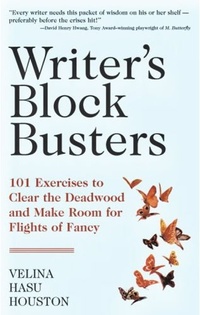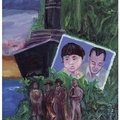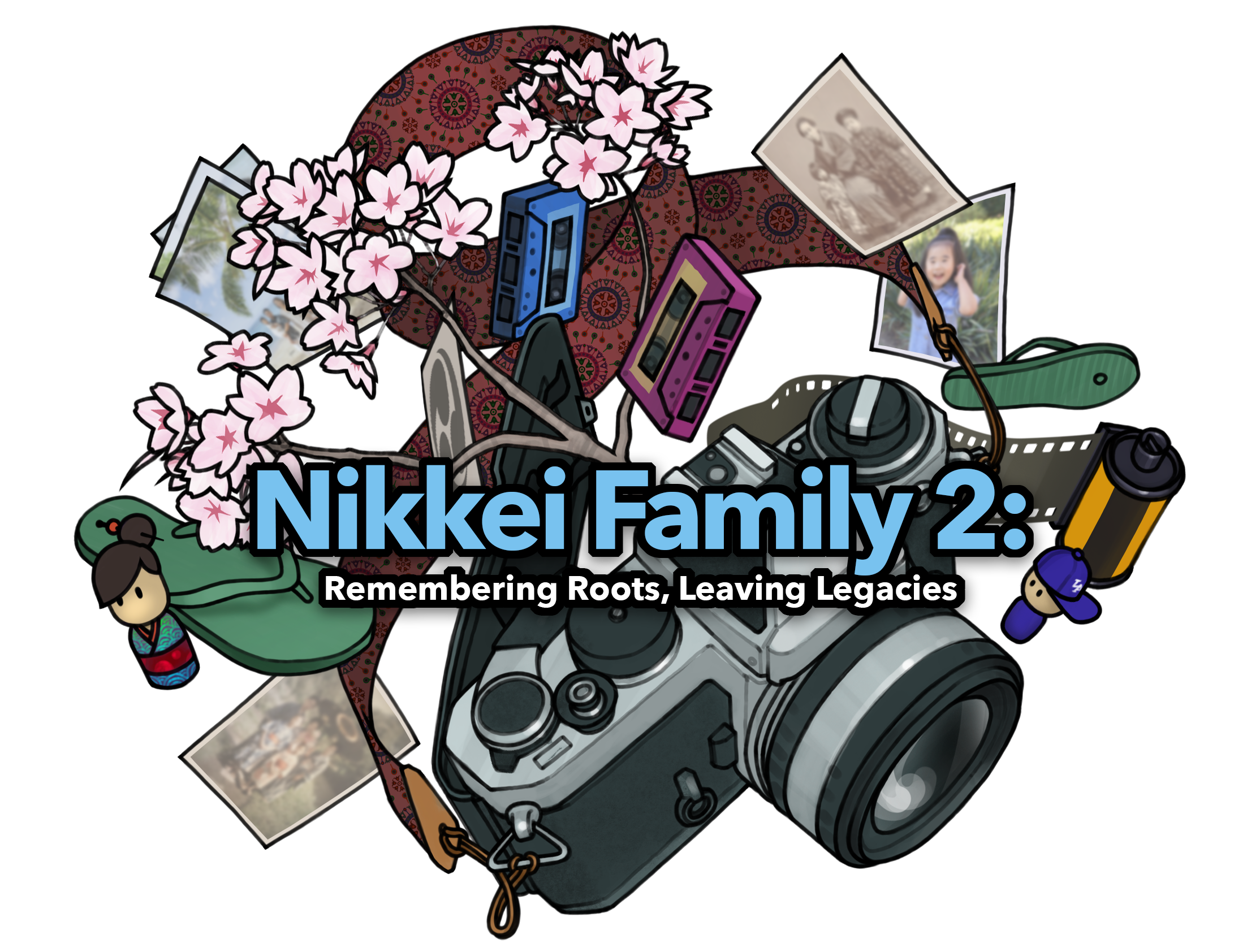>>Part 4
As a multicultural and multiracial playwright
Houston had a talent for writing since she was a child, and won a Kansas state award for a poem she wrote in high school. After earning a degree in journalism from Kansas State University, she moved to Los Angeles and earned a master's degree from the University of California, Los Angeles in 1981, writing the play "Asa ga Kimashita." She then earned a doctorate in cinema at the University of Southern California, where she currently teaches theater theory. In 1990, she also established a graduate school for screenwriting at the university, where she provides creative direction.
She has been a remarkable playwright, and as I mentioned at the beginning, over 30 of her plays have been performed in Asian, African and other theaters. Because her works often contain both Asian and African themes, Asian theaters tend to shy away from her works because they lack the Asian elements to be performed in Asian theaters, and African theaters tend to lack the Asian elements to be performed in African theaters. Ironically, she is welcomed by European and American theaters and directors. In fact, her representative work, "Tea," has been performed more often in European and American theaters than in theaters of color.
She calls this situation "oppression of people of color." Asian theaters such as East West Players (EWP) were originally established as a resistance to discrimination from white society. Theatrical activities aimed at eliminating discrimination have focused too much on their own ethnicity, excluding other ethnicities. Recently, there are Asian theaters that are not bound by such restrictions, but I think that ultimately they should engage in activities that transcend ethnicity.
Nurturing future playwrights
How does Houston teach her creative writing classes? And how does she write her own plays? She asserts that ideas come one after another and never run out. Where do those ideas come from? A hint can be found in a book published last year (2008) called "Writer's Block Busters." The subtitle is "101 Exercises to Eliminate the Useless and Take a Journey of Imagination."
In the preface, he states categorically that creative writing cannot be taught, and then goes on to explain the advice he gives to students who want to be playwrights. For example, after reading a book, he tells them to talk about it from a writer's point of view, and to think about why it is important when writing a play. In the main part of the book, he presents the specific assignments he has given to students as a teacher for the past 20 years.
The first lesson is an exercise to clarify what kind of person the character is. The second lesson is a problem to write about the time from waking up in the morning to meeting another person who needs you, and your reaction to that request. Each problem is short, and the guidelines at the beginning are given to not overthink it.
First steps as a novelist
I met Houston and her son Kiyoshi in Los Angeles about 10 years ago, and we talked over Chinese food in Chinatown. At the time, she said she wanted to turn "Tea" into a novel. I think she felt that a novel was the best way to attract a wide audience. She said it would be difficult because the writing style is different from a play, but in a recent email she told me that she already had the novel version and wanted to publish a Japanese version. I hope this will come to fruition, but at the same time, I also hope that it will be made into a movie.
*Translations quoted in the text are by the author unless otherwise noted.
Published plays by Belina Hass Houston
Tea. Unbroken Thread, Roberta Uno, ed., University of Massachusetts Press, 1993
・Asa Ga Kimashita (Morning Has Broken). The Politics of Life: Four Plays by Asian American Women, Velina Hasu Houston, ed., Temple University Press, 1993
The Matsuyama Mirror. Short Plays for Young Actors, Craig Slaight & Jack Sharrar, eds., Smith and Kraus, Lyme, 1996.
・As Sometimes in a Dead Man's Face. Asian American Drama: 9 Plays from the Multiethnic Landscape, Brian Nelson, ed., Applause Theatre Books 1997
・Kokoro (True Heart). But Still, Like Air, I'll Rise: New Asian American Plays, Velina Hasu Houston, ed., Temple University Press, 1997
・Hula Heart. Eight Plays for Children, Coleman A. Jennings, ed., University of Texas Press, 1999.
E-books (plays other than those mentioned above)
・Kapiolani's Faith. Alexander Street Press, 2009
・Ikebana: Living Flowers. Alexander Street Press, 2009
・Japanese and Multicultural at the Turn of the Century. Alexander Street Press, 2009
・Calling Aphrodite. Alexander Street Press, 2009
Other works
・Writer's Block Busters: 101 Exercises to Clear the Deadwood and Make Room for Flights of Fancy, Smith & Kraus Pub Inc., 2008
"Private Goodwill Ambassadors: Japanese War Brides in America" in "The Path of Photo Brides and War Brides" edited by Noriko Shimada, Akashi Shoten, 2009
Edited and co-authored The Politics of Life: Four Plays by Asian American Women, Houston, Temple University Press, 1993.
But Still, Like Air, I'll Rise: New Asian American Plays, Temple University Press, 1997
・No passing zone, Amerasia Journal Vol. 23, No.1, 1997
Premiere (title, year, theater company, venue) and brief introduction of the work: Asa ga Kimashita, 1981, UCLA, Los Angeles
The play depicts the struggles of Setsuko, the mother who married a black American soldier in Japan. Actress Lilis Takahashi plays Setsuko at the Nova Theatre in San Francisco from March 6 to April 6, 1985.
American Dreams, 1981, UCLA, Los Angeles
The film depicts Setsuko, a war bride,'s experience of discrimination in America.
Tea, 1985, Asian American Theater Company, San Francisco
It depicts the experiences of Setsuko, a mother of a war bride, and four other war brides. In 1988, it was selected as one of the top ten plays by the Los Angeles Times.
Thirst, 1986, Asian American Theater Company, San Francisco
Two sisters and their mixed race sister struggle with grief after the death of their mother and ultimately come face to face with the rifts that have simmered within their family.
・Necessities, 1991, Old Globe Theatre, San Diego
A successful woman adopts a baby to give her life meaning, but as the baby becomes merely an object to enhance her life, she begins to realize that the things we really need in life can't be bought or rented.
・Tokyo Valentine, 1992, EWP, Los Angeles
The film depicts the romance between a black woman and an Asian woman who protest against hate crimes (crimes motivated by hatred towards people of different races, etc.).
・The Matsuyma Mirror, 1993, Honolulu Theater for Youth, Hawaii
After her mother's death, a girl begins menstruating and must deal with her body's changes and her desire not to grow up.
・Kokoro, 1994, Theatre of Yugen, San Francisco
Based on the actual case of a Japanese mother and child who committed suicide on the West Coast of the United States in 1985, the film depicts the differences in family consciousness and views on life and death between Japan and America.
・As Sometimes in a Dead Man's Face, 1994, EWP, Los Angeles
The film depicts the relationship between a Japanese mother, Emiko, her Amerasian daughter, Samantha, and their adopted Amerasian boy, Daniel.
・Japanese and Multicultural at the Turn-of-the-Century, 1994, Asia Society National Public Radio
An Amerasian mother and child discuss their identity in a short piece commissioned by Asia Society and broadcast on radio.
・Hula Heart, 1996, Honolulu Theater for Youth, Hawaii
A Hawaiian boy moves to California, where he finds it hard to find people who understand his hula dancing, but as he adjusts to his new world he also comes to understand the importance of his culture in life.
・Ikebana, 1999, Urban Stages, New York
Ayame Itamura, a daughter who has always been devoted to her respected father, is reluctant to accept the marriage proposal her father brings to her. At that time, a mixed race girl named Hanako comes to the house as a maid, disrupting Ayame's life, which had been as perfect as a flower arrangement.
The Lotus of the Sublime Pond, 2000, Jewish Women's Theater Project, Hollywood
A lively girl from the provinces becomes the emperor's favorite. The emperor cannot change her, but the chaos that follows her arrival at the court changes the country. The title is a reference to "The Lotus in the Sublime Pond" in the Tale of Genji, an allegory for the beautiful Yang Guifei.
- The Peculiar and Sudden Nearness of the Moon, 2006, Sacramento
When a white woman marries a white man and gives birth to a black child, she embarks on a journey to discover who she is and how strange life can be.
The Shedding Tiger, 2001, Sacramento Theater Company, Sacramento
After the collapse of the Japanese bubble economy, Minako Sakurai, a daughter of a wealthy family, finds herself changing after inheriting her father's fortune. Like the fox in tiger's clothing, Minako also begins to reveal her true self, but through this experience she discovers her humanity. The story is set in Kyoto in 1998.
・Waiting for Tadashi, 2002, New Brunswick George Street Playhouse, NJ
Tadashi Rain, a war orphan born to a black American soldier and a prostitute, turns 50 and sets out on a journey to find his adoptive mother, whom he has been estranged from for 20 years. Through this journey, Tadashi begins to discover himself.
・The House of Chaos, 2007, American Repertory Theatre,
A Japanese woman who has been cheated out of her fortune, inheritance and raped takes extraordinary measures to restore her reputation. Inspired by Euripides' Medea.
・Calling Aphrodite, 2007, International City Theater
A woman who was exposed to the atomic bomb in Hiroshima travels to New York for treatment after the war as the Atomic Bomb Maiden. The Greek goddess Aphrodite talks to the characters about women, beauty and love.
Performances in Japan (title of work, year of performance, name of theater company or producer, place of performance)
・Tea 1993, Amagasaki Piccolo Theater, Osaka ・Tea 1995, International Youth Theater Center Theater KAI, Tokyo ・Tea 1998, Hiroshima University Hiroshima ・Tea 2009, Theater Company Plugin Small Theater Paradise, Tokyo ・Hiroshima, Aphrodite - Woman and Shadow - (Calling Aphrodite) 2008
Tokyo Theatre Ensemble Brecht's Playhouse Tokyo
Television drama scriptwriting and production
American Dreamers, PBS, 2006
This film examines the lives of city dwellers from the perspective of people living in the American desert.
Reference material : "Fighting Women" Yasuko Kawarazaki, AALA Journal No. 2 1995
・Japan's Post-War Democratization-agrarian reform and women's liberation in Houston, Asa Ga Kimashita, Masami Usui, AALA Journal No.5 1998
・Asian American Culture on Stage, Yuko Kurahashi, Garland Publishing, 1999
Yellow Light, Amy Ling, ed., Temple University Press, 1999
・Identity Politics of Asian American Drama; the theoretical landscape of Philip Kan Gotanda and Velina Hasu Houston, Masayuki Takashi, Osaka University of Foreign Studies, British and American Studies 26, 2002
・"The Children of Amerasian" by S. Murphy Shigematsu, Shueisha, 2002
・"Hiroshima, Aphrodite - Woman and Shadow" Performance Pamphlet August 10, 2008 ・"The Story of the Bride Who Crossed the Sea" Overseas Migration Museum News No. 17 August 2009 Overseas Migration Museum
Reference video : Do 2 Halves Really Make a Whole? Directed by Martha Chono-Helsley, CAAM, 1993
Reference Websites
http://www.velinahasuhouston.com/
The official website of Belina Hass Houston. It contains detailed information about her profile, publications, performance records, awards, lectures, symposiums, and reviews of Houston. It also includes photos of her parents and other family members.
*This article is a reprint of the seventh installment of the column series "From the Perspectives of Two Countries" in Renso Publishing 's online magazine "Kaze," which features information about new books, such as articles linking new books to current issues and daily topics, as well as monthly bestsellers and review columns of new books.
© 2009 Association Press and Tatsuya Sudo












